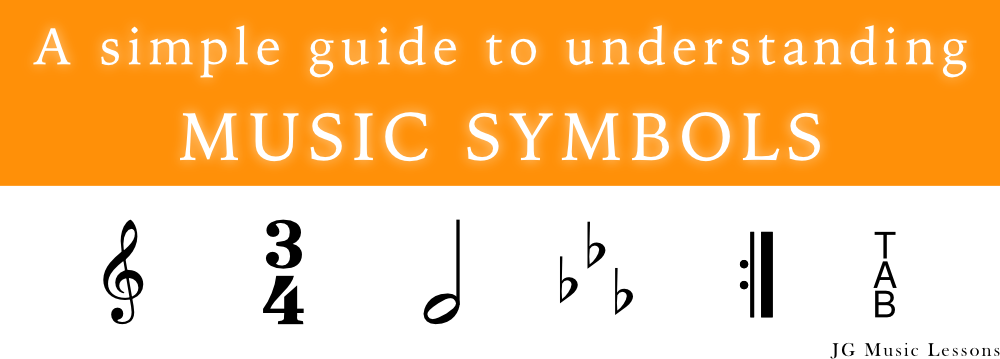This simple guide covers common and essential symbols used to read and write music. You can use this resource whenever you need helping understanding a specific symbol in a piece you are learning or are composing.
The guide is divided into several sections for you to find what you’re looking for. Simply click on any section to skip there.
Table of contents
Basics to reading sheet music
Clef symbols
Notes on the staff
Note lengths
Time signatures
Key signatures
Bar lines
Repeat and jump symbols
Guitar notation symbols
Dynamics symbols
Tempo markings
Articulation symbols
Other music symbols
Basics to reading sheet music
This section will help you understand the basic components that are used in sheet music.
You’ll get a clearer sense of a standard layout and what the symbols mean.
First, see the image below to know the terms used for different symbols on a piece of music and then I’ll give you a simple definition of each term.

Staff: the staff is the set of 5 lines that are used to write notes. The notes are written on the lines or in the spaces between the lines. We’ll look at how to read all the notes on the staff later on.
Clef: This symbol is used to determine the note names on the staff lines. The note names change depending on the clef stated. The clef in the image above is called a treble clef (more on this in the next section).
Time signature: This symbol is used to determine the beats and length of a measure that repeats throughout a piece of music.
The following sections will go into more detail for these components used in sheet music.
Clef symbols
You can think of the clef symbol as a grid that defines the notes in the staff lines. This means that a note in the same location of the staff will have a different note name depending on the clef symbol used.
Treble clef (also known as G clef)
The most commonly used clef is called the treble clef, also known as the G clef. This is because the symbol wraps around the line for a G note as you’ll see in the following image:
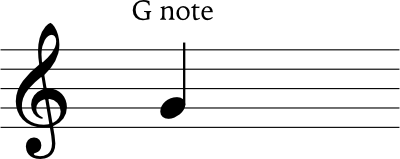
The treble clef is used for instruments that have a higher range of notes such as the guitar, violin, trumpet, and saxophone.
The following section of this post will show you all of the notes that belong to the staff lines using the treble clef.
Bass clef
The bass clef is used for instruments with a lower range of notes such as the bass guitar, double bass, cello, and trombone.
The bass clef symbol has two dots that go above and below the second line, which is the F note like this:

Alto clef, also known as C clef
This is a less commonly used clef which is primarily used for viola. The C clef has a sort of letter B shape which is centered on the staff and makes the middle line a C note like this:
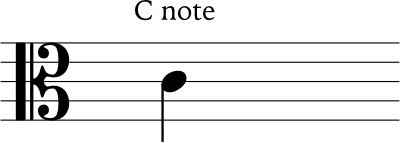
Combining clefs (used for piano)
Combining clefs is used for piano because the range of written notes is usually wider. This makes it easier for an instrumentalist to read notes in higher or lower ranges without having to use multiple ledger lines (short lines used to write notes past the staff lines).
The combined clefs usually have a bracket on the left to indicate that the two staff lines are joined for one instrument.
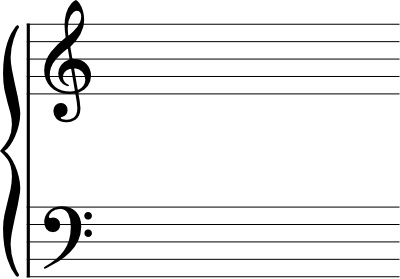
Now that we know what these clefs mean, we can start to learn the note names used in music.
Notes on the staff
Music notes are written either on the lines or spaces of the staff.
From bottom to top, the notes on the spaces are F, A, C, E. Think of the word “face” to remember these notes.
From bottom to top, the notes on the lines are E, G, B, D, F. You can think of this popularly used phrase “Every good boy does fine”.

Whenever you extend past these staff, you can use ledger lines which are short lines to write notes in higher or lower ranges. See how the ledger lines are used in the following image.
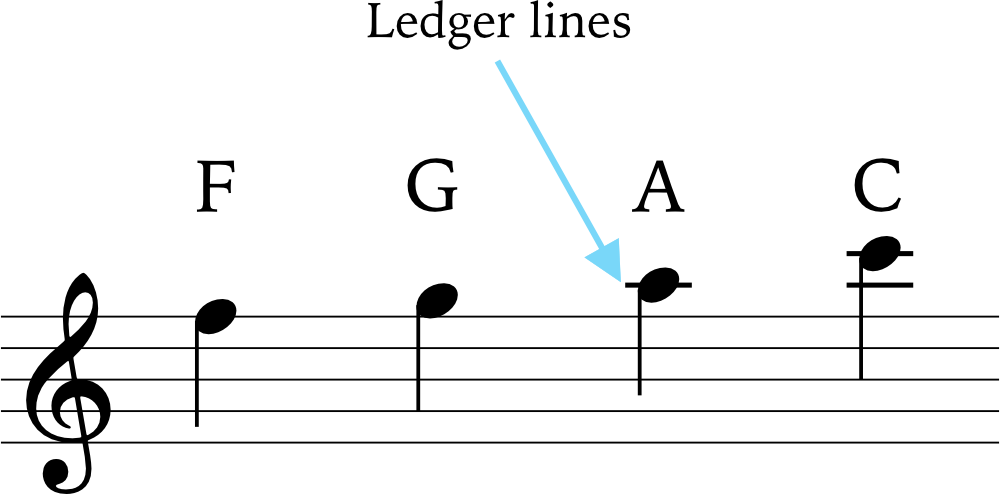
Here is a chart of all the music notes on the treble clef including additional notes on the ledger lines:

Accidentals (sharp, flat, natural)
In music notation, accidentals refer to the symbols used to alter a note such as indicating that a note moves a half step up or down.

Sharp symbols are used to raise a note by a half step. For example, the note C# is a half step above C.

Flat symbols are used to lower notes by a half step. For example, the note Db is a half step below D.

The natural symbol is used to play a note without raising or lowering it when there were accidental symbols before it.
Here is an example in music notation of what these accidentals look like:

Note lengths
This section covers the symbols for different types of music notes, how long they last, and their equivalents for silence, also known as rest in music terms.
Here is an overview of what these musical note symbols mean in 4/4 time (more on time signatures later).
Symbol
Duration
Note name
Rest symbol

4 beats
Whole note


2 beats
Half note


1 beat
Quarter note


1/2 beat
8th note


1/4 beat
16th note


1/8 beat
32nd note

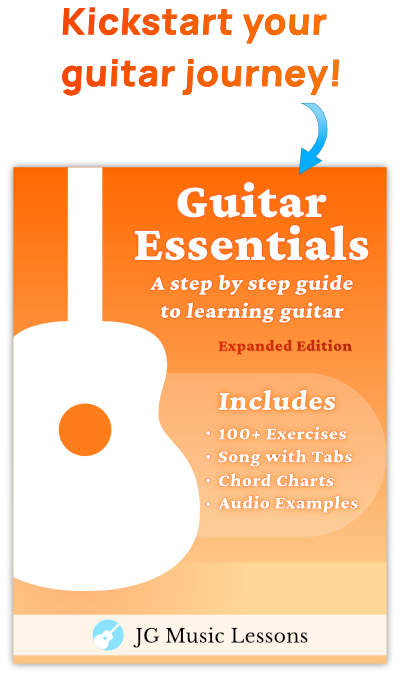
Dotted notes
Any time you see a dot added to a note, it adds half of its value to the length of the note. For example, a dotted quarter note means you add 1 beat plus 1/2 which equals 1 1/2 beats. Here are some other examples of dotted notes below.
Symbol
Duration
Note name
Rest symbol

3 beats
Dotted half note


1 1/2 beats
Dotted quarter note


3/4 beat
Dotted 8th note

Note ties
Another symbol used to extend the length of notes, especially between measures is to use note tie symbols. This means you don’t play the note twice but continue playing a note for the combined duration where you see a connecting line. See the note tie example below.

Time Signatures
A time signature tells you how long each measure lasts in a piece of music. The top number of a time signature refers to how many beats will go into a measure while the bottom number refers to the note value (for example, 4 for quarter notes, 8 for eight notes).
In other words, 4/4 time means that there are 4 beats in a measure, each having the value or length of a quarter note.
4/4 time signature symbol:

3/4 time means that there are 3 beats in a measure, each having the value or length of a quarter note.
3/4 time signature symbol:

6/8 time means that there are 6 beats in a measure, each having the value or length of an eighth note.
6/8 time signature symbol:

For a more in depth explanation, see the post: A simple guide to understanding time signatures.
Key Signatures
Key signatures define the tonality of a piece of music. By changing the accidentals in the notes, you can play in different keys. Instead of having to change one specific note every time, you can do this by including it in the key signature to make the change apply every time.
Every key signature has a Major and minor key that are related. This is because the related keys share all the same notes except their starting point is different.
The image below shows you what all the different time signatures look like on the staff.
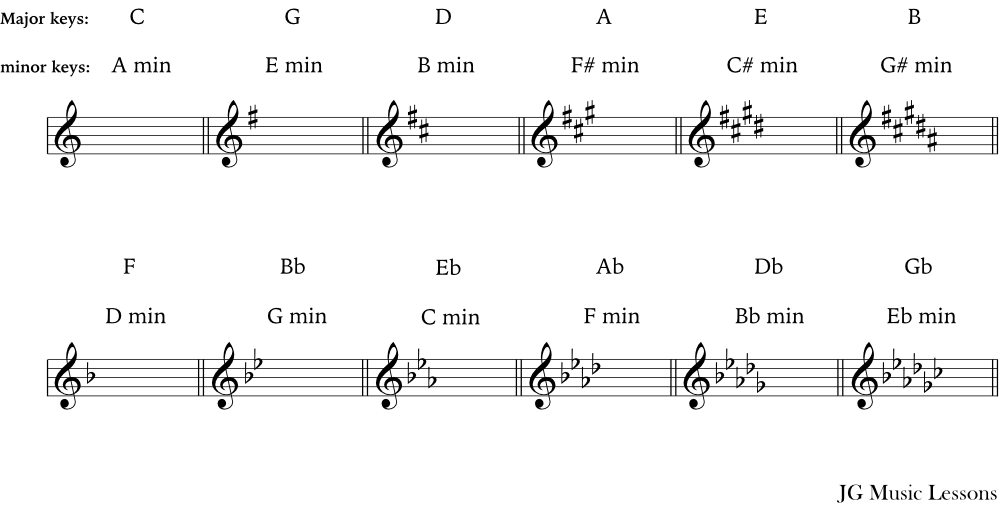
For more details, check out this simple guide to understanding key signatures.
Bar lines
Here is a brief explanation of bar lines used in sheet music.
- Single bar lines are used to separate measures (see end of measure 1 in the bar line symbols chart below).
- Double bar lines are used to separate sections in a piece of music. (See the end of measure 2 below).
- Final bar lines are used to indicate the ending of a piece of music.
The chart below shows you what these bar lines look like on sheet music.

Repeat and jump symbols
Repeat signs have a double bar line with two dots to indicate which measure to repeat. See the symbols below.

Repeat section symbol. Dots facing to the right indicate the beginning of a section that is to be repeated.

Repeat section symbol. Dots facing to the left indicate the ending of a section that is to be repeated.
For example, the chart below indicates to repeat measures 1 and 2.

Numbers for section endings – brackets with numbers are used to indicate where a section ends and repeats. When a section is repeated you would continue with the next number. For example, in the chart below, you would play measures 1, 2, and 3 then play measures 1, 2 and 4 the second time. These numbers can simply be referred to as “1st or 2nd endings”.

D.C. – these abbreviated letters stand for Da Capo (in Italian), meaning to go back to the top or beginning of the piece.
D.S – these abbreviated letters stand for Da Signo (Italian), meaning to jump to “the sign” which looks like this:

Coda – an ending section in a piece of music. This is indicated by “To Coda” along with the following symbol:

Here is an example of these jump symbols below. In this example, you would first play measures 1 to 4, then repeat measures 1 and 2, then skip to measure 4.


Repeat measure symbol. This means you repeat what was indicated in the previous measure.
For example, this chart means you play a G Major chord for 4 measures.

Fine – End (in Italian). Sometimes written as Fin (in French).
D.C. al fine – Go back to the beginning of the piece (D. C.) until the end (fine).
D.S. al fine – Go back to Da Signo “the sign” and play until the end (fine).
Guitar notation symbols
Guitar fingering symbols
These symbols are used for guitar music to indicate what fingers to use when playing notes. These symbols are for “righties”, meaning you hold the guitar like most people and use your right hand to pick or strum the strings (picking/strumming hand) and your left hand to press down notes (your fretting hand)
Fretting hand symbols:
1 = pointer finger
2 = middle finger
3 = ring finger
4 = pinky finger
(thumb goes behind the guitar)
Picking / strumming hand symbols:
p = thumb (pulgar in spanish)
i = pointer finger (indice “)
m = middle finger (medio “)
a = ring finger (anular “)
c = pinky finger (chico “)
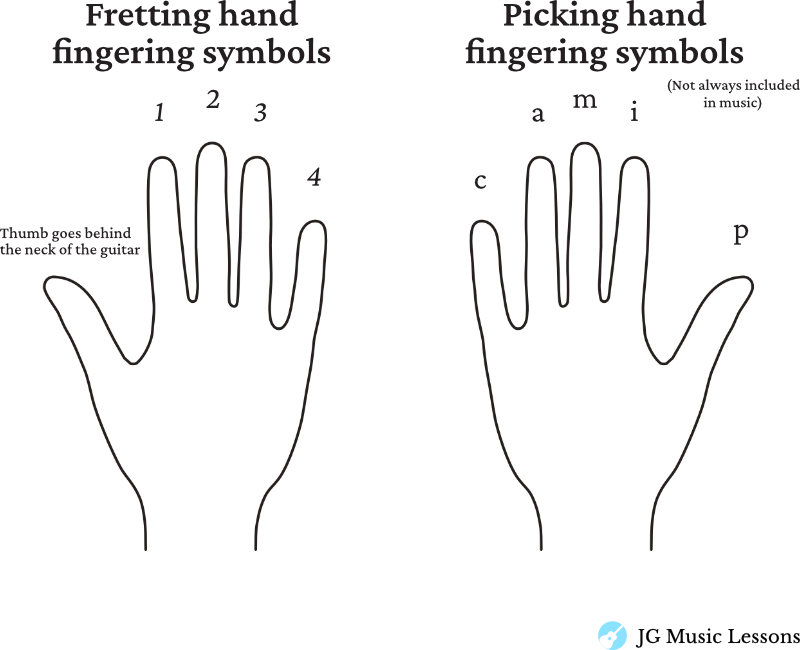
How to read guitar tabs
Guitar tabs (short for tablature) simplify music notation to tell you which string and fret to play. Under the staff, you’ll see a connected set of 6 lines to represent each of the 6 guitar strings.
For TAB lines, the top line represents the thinnest string, while the lowest line represents the thickest string. The numbers on the tab lines represent which fret to play (0 means to play an open string).
Here is an example of guitar tabs below:

How to read chord charts
For the guitar chord charts on this site, the top horizontal line of the chord chart represents the high E string and the bottom horizontal line represents the low E string. The vertical lines separate each fret. The numbers in the blue dots tell you which fingers to use on the fretting hand.
The letters on the right of the charts tell you what notes you are playing on each string. See the image below to understand the different parts of a chord chart.
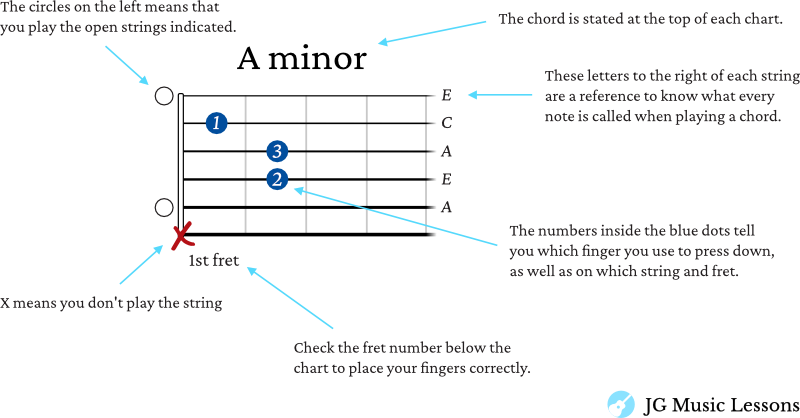
Tab notation – example
Some sheet music notates string symbols in standard notation string instead of using guitar tabs. See examples 1 and 2 to compare different ways of notating music.
Here is an example of writing notes using tabs notation.
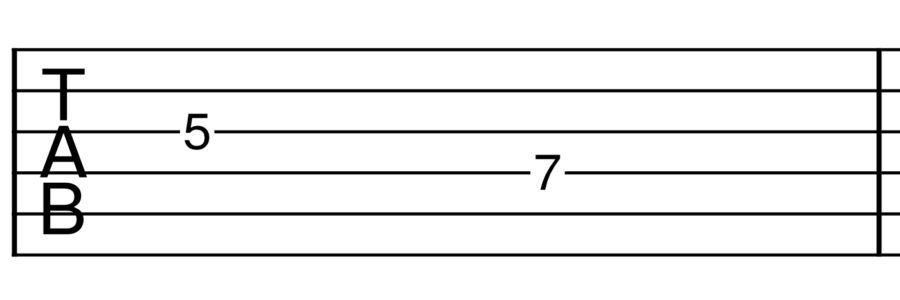
String notation – example
Here are the same notes as the previous example but written in standard notation including string symbols. The numbers inside the circles indicate what string to play the note on.

These string symbols are just another way to help to find your way around the fretboard if you don’t have tabs for music you want to learn. For more information, this post on how to learn guitar with tabs covers some of the advantages and disadvantages of using tabs.
Common guitar symbols

: Hammer on symbol is used to indicate pressing down on the next note without picking the string again.
Here is an example of using a hammer on symbol. The numbers above the note on the staff represent which fingers to use on your fretting hand. As you can see the symbol is also mirrored in the TAB lines.


: Pull off symbol is used to indicate releasing your finger to play the next note without picking the string again.
Here is an example using the pull of symbol:
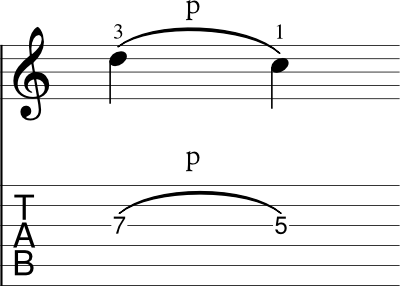

: The slide from below symbol is used to play a note then slide up to the next note without picking the string again.
Here is an example using the slide from below symbol. I generally recommend starting the slide one or two frets from below the indicated note.
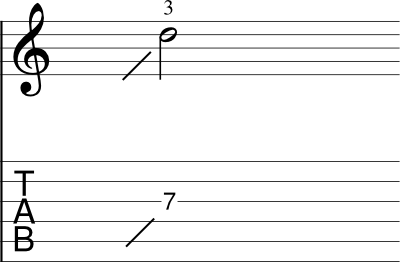

: The slide from above symbol is used to play a note then slide down to the next note without picking the string again.
For the slide from above symbol, I generally recommend starting the slide one or two frets from above the indicated note. Here is an example:

Let ring: This symbol is used to indicate that notes should continue to ring out rather than stopping them when playing the next note. Sometimes this is written on the top left at the beginning of a piece of music (see example 1 below). Other times it is specified within a section of music using dotted lines as shown in example 2 below.
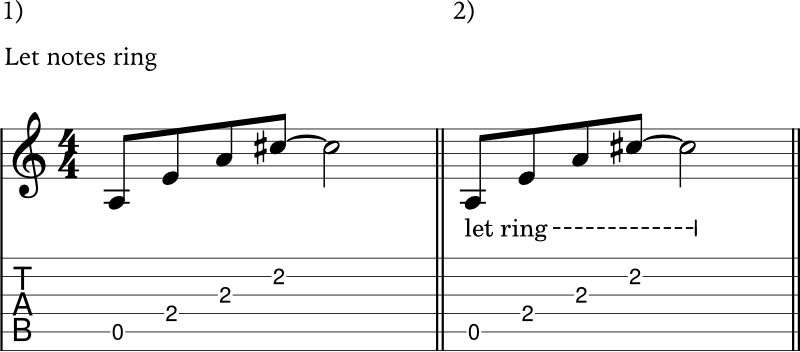
Treble clef 8va bassa (an octave lower): A treble with a small 8 under is used for guitar music to transpose the notes an octave lower.
This is because a middle C in notation is actually an octave above the middle C on the guitar. To make reading guitar music more comfortable within the staff lines, we can use the 8va bassa treble clef as shown in the chart below.

Barre chord symbols: Whenever barre chords are used within a part of a song, you might see symbols that say B.1, B.2, etc… Sometimes you will also C.1, C.2 which refers to the word “cejilla” or barre in Spanish.
Here is an example of using barre chord symbols from the song, Moonlight Sonata.
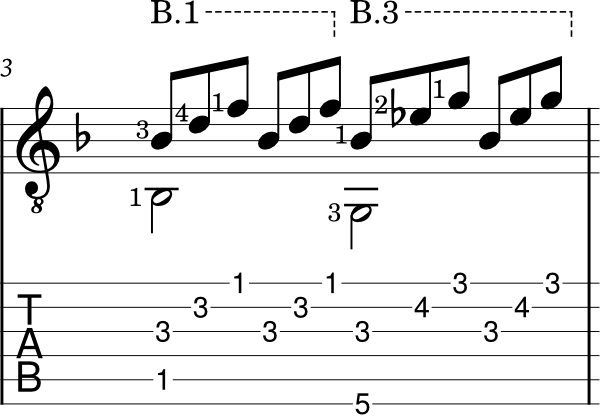
Harm. = indicates a harmonic—a technique that produces a chime-like tone by lightly touching the string at a specified point (typically 12th, 7th or 5th fret) and plucking it without pressing the fret down.
A. harm = (artificial harmonic) A technique where you lightly touch a string with one finger while fretting it with another to create a bell-like, harmonic tone that isn’t naturally found on the open string. For example: A. Harm (14th fret)
Dynamics symbols
Dynamics symbols are used to indicate playing louder or softer. Here are some commonly used dynamics symbols which come from Italian words:
pp = pianissimo (very quiet)
p = piano (quiet, a bit louder than pp)
mp = mezzo piano (moderately quiet)
mf = mezzo forte (moderately loud)
f = forte (loud)
ff = fortissimo (very loud)

= crescendo (gradually play louder). Also written above the music as “Cresc”

= decrescendo (gradually play softer). Also written above the music as “Descresc”
dim = diminuendo (gradually play softer and slower).
rit = ritardando (gradually make the tempo slower).
As you’ll see in the example below, dotted lines are often used to specify which part of the music is affected by the dynamic symbol.

a tempo = return to the original speed of the piece after a change in tempo.
Tempo markings
Tempo markings are commonly written in Italian. See the following charts for their English meaning and their BPM (beats per minute).
Slower tempos
| Tempo marking | English meaning | BPM (Beats per minute) |
|---|---|---|
| Larghissimo | Extremely slow | 24 bpm and under |
| Adagissimo / Grave | Very slow | 24 – 40 bpm |
| Largo | Slow and broad | 40 – 66 bpm |
| Adagio | Slowly with great expression | 44 – 68 bpm |
| Adagietto | Slightly faster than Adagio | 46–80 bpm |
| Lento | Slow | 52–108 bpm |
Moderate tempos
| Tempo marking | English meaning | BPM (Beats per minute) |
|---|---|---|
| Andante | Slow moderate (walking pace) | 56–108 bpm |
| Andantino | Typically slightly faster than Andante | 78 – 108 bpm |
| Moderato | Moderate | 86–126 bpm |
Faster tempos
| Tempo marking | English meaning | BPM (Beats per minute) |
|---|---|---|
| Allegro | Lively | 100 –156 bpm |
| Vivace | Faster than Allegro | 136 – 160 bpm |
| Presto | Very fast | 168 – 200 bpm |

= fermata (sustain the note, longer than the length of the note indicated at the performer’s discretion)
a piacere = (Italian for “at pleasure”) lets the performer play with freedom, often by changing the tempo or using rubato (slightly speeding up or slowing down notes) to add emotion.
Articulation symbols

slur = a curved line that connects notes, indicating they should be played or sung smoothly and connectedly without separation. Playing notes in a connected manner is also referred to as playing “legato”.

staccato = note should be played in a short and separated manner, creating a crisp, punctuated sound.

marcato (aka marc) = note, chord, or passage should be played with more emphasis in contrast to other parts of the piece).

tenuto = horizontal line above or below a note to indicate that it should be sustained to its full value or slightly emphasized.

accent = indicates that a note should be played with extra emphasis compared to the surrounding notes. It gives the note a stronger attack, making it stand out.
Other music symbols
Grace notes – small notes that are written besides notes for embellishment. The two types of grace notes are:
- Acciacatura (grace note) : played before the beat (have a line through the stem)
- Appogiatura (grace note): played on the beat (have a normal stem)
See the image below to see examples of these grace notes.

See this video to hear the difference between these grace notes.
/ : slashes in a measure are used when the music only indicates chords and not specific notes. For example:

Rhythmic slash notation is used to indicate rhythm when using chords. This kind of rhythmic notation has a different look than regular notation which is slanted like this:

Wrapping up
In this post, we covered many frequently used music symbols and their meanings to read sheet music. It may be overwhelming to try learning them all at once, but as you continue to review these symbols, you will get a better understanding with how they work.
You can save this post as a resource to come back to whenever you forget what certain music symbols mean.
If you want to practice learning songs that use many of the symbols covered here, I encourage you to check out the sheet music with guitar tabs resource on this site.
📘 Get the free guitar practice guide here!
All the best,
JG Music Lessons
References:
- wikipedia.com/tempo
- Elson, Louis Charles (1909). Elson’s Pocket Music Dictionary: The Important Terms Used in Music with Pronunciation and Concise Definition, Together with the Elements of Notation and a Biographical List of Over Five Hundred Noted Names in Music. Oliver Ditson.
Start Playing Better, Faster
by becoming a Pro Member! ✨
Transform your playing by enjoying benefits such as:
• 📙 Exclusive Lesson PDFs and Ebooks
Get access to a growing library of clear, downloadable resources—save time and skip the clutter.
• 🎼 Full Song Lessons
Break down your favorite songs step by step, and play them with confidence.
• 🚫 Ad-Free Learning
Focus better with a distraction-free environment.
• 🎁 Store Discounts
Save 50% off on all song PDFs, charts, audio tracks, bundles, and design printables.
• 💬 Member Support
Got questions? We’ve got your back, helping you stay on track!
👉 Join Here!
Level up with the FREE guitar practice guide and effectively improve your playing! 🎸
Get it sent to your email!

